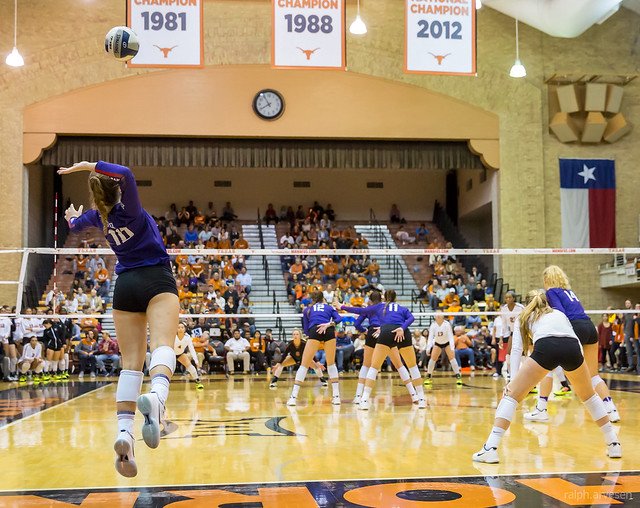- Improve Your Volleyball with Coach April
- High School Varsity Volleyball
- What's an ace in volleyball?
 Dear Volleyball Mom,
Do You Know What Sets My Private Volleyball Training Apart From Anyone In Vegas?
I invite You to read what my private volleyball training mission says before considering hiring me as a private volleyball coach because I'm not available for everyone.
Dear Volleyball Mom,
Do You Know What Sets My Private Volleyball Training Apart From Anyone In Vegas?
I invite You to read what my private volleyball training mission says before considering hiring me as a private volleyball coach because I'm not available for everyone.The Power Of The Ace In Volleyball: Improve Your Team's Serving Game
An ace in volleyball is your way to victory! This guide offers strategies for volleyball coaches to develop powerful servers that dominate from the service line
It's the ultimate goal for any server, because it allows your team to score a point without having to rely on your teammates.
As a high school volleyball coach, whether you're leading the varsity, junior varsity, or freshman team, teaching your players how to serve effectively and score aces can be a game-changer.
To be clear, if anyone on the opposing team does make contact with the ball but can't return it over the net or keep it in play, it's still considered an ace.
The key is to make your serve as tough as possible so the other team cannot replay the ball and get it back over the net.
For The Freshman Coach
What is An Ace in Volleyball?
Start by emphasizing the importance of a proper toss, contact point on the ball and follow-through.
Encourage your players to practice serving regularly, both during team practices and on their own time.
For Junior Varsity Volleyball Coaches The Importance of Serving Technique
For junior varsity coaches, your players probably have a bit more playing experience and are ready to start learning more advanced serving techniques.
Work on drills that focus on serving to specific zones on the court, such as deep corners or the space between players (known as "the seam").
For Varsity Volleyball Coaches What Does An Ace In Volleyball Mean To Your Team
Varsity coaches, your players are probably already proficient in basic serving techniques and may even have experience with jump serves.
Your goal should be to improve and refine their skills and help them develop a strategic approach to serving.
Encourage them to study the opposing team's passers and identify weaknesses to exploit.
Teach them how to vary the speed, placement, and trajectory of their serves to keep the other team guessing.
Serving Volleyball Drills For Varsity/College Players:
Full Court Serve Receive With Two Passers and Two Float/Jump Servers
As your players improve, increase the difficulty of your drills by adding pressure situations, such as serving after running a sprint or having to score a certain number of points in a row.
Volleyball Ace Scoring
Practice Drills
Players are given a specific amount of time to serve a pre-determined number of balls to the target area formed by the chairs. hitting the middle of the chairs is rewarded more than just hitting the chairs in this case but coaches can come up with their own rules in irder to make this a tougher or easier drill.
The Serving Ladder Volleyball Drill
One effective drill for all levels is the "serving ladder."
Set up cones or markers at various distances from the net, each representing a different point value.
Players must serve to these zones, starting with the closest and moving back after successfully hitting each one.
This drill helps players develop accuracy and control while also adding a competitive element.
Players are given a specific amount of time to serve a pre-determined number of balls to the target area formed by the chairs. hitting the middle of the chairs is rewarded more than just hitting the chairs in this case but coaches can come up with their own rules in irder to make this a tougher or easier drill.
What's The Mental Preparation Needed To Score An Ace In Volleyball?
Another important aspect of serving is the mental preparation needed before during and after the serve.
Teach your players to develop a pre-serve routine, which might include
- taking a deep breath
- bouncing the ball a specific amount of times
- measuring your steps from the service line
- visualizing the serve
- repeating a positive affirmation
This routine can help them stay focused and calm under pressure, increasing their chances of executing a successful serve.
Keeping Stats on Aces Scored During A Match
As a coach, it's also crucial to track your team's serving stats during matches. Keep a record of each player's serving percentage, aces, and errors.
Use this data to identify areas for improvement and to celebrate individual and team successes.
Encourage your players to set personal goals related to their serving performance
How To Prepare For Scoring Aces During Game Situations
When it comes to game situations, emphasize the importance of serving aggressively but intelligently.
Teach your players to recognize when to take risks and when to prioritize consistency.
Players serve to Zone 2 then run and shag their ball and repeat the drill from the opposing court.
Coaches can designate a certain amount of time for the drill duration or they can decide on a specific number of serves that need to be tough an inbounds before the drill is done.
Freshmen Coaches How To Prepare For Ace Scoring Matches
For freshman coaches, focus on helping your players build confidence in their serving abilities.
Celebrate every success, no matter how small, and provide constructive feedback when errors occur.
Encourage them to cheer each other on and create a supportive team environment.
Junior Varsity Coaches How To Prep Your Players To Score More Aces
Encourage them to experiment with different techniques and find what works best for them.
For Varsity Coaches
Varsity coaches, your players should be well-versed in various serving strategies and techniques.
Work with them to develop a serving game plan for each match, based on the strengths and weaknesses of the opposing team and the strengths and weaknesses of each server.
Some servers will have a better short serve than others or some can serve the line better than others so plan accordingly.
Encourage them to take calculated risks and to trust their skills in high-pressure situations.
Varsity Serving Concepts
One advanced serving technique to teach your varsity players is the jump spin serve.
This serve involves tossing the ball high, taking a dynamic approach, and hitting the ball with topspin as you jump.
While more challenging to execute consistently, the jump spin serve can be a powerful weapon when you can control all aspects of this skill.
In my annual Breakfast Club for College Players summer class which I have been doing for college players home for the summer and need a place where they can get college paced volleyball drills done so they can report back to their college coach what they accomplished.
Many college players are required to send video of their summer workouts back to their college coaches so I provide a great environment where they can get that done.
College players are working on their jump float serve technique.
To help your players improve their jump spin serve, break down the technique into smaller components and practice each one separately.
Another important concept to teach your varsity players is the idea of serving to the "seams" between players. By targeting these spaces, you can create confusion and hesitation among the opposing team's passers, increasing the likelihood of an ace or a poor pass.
Create A Team Culture That Embraces Aggressive Serving
Encourage your players to take smart risks and to view serving as an opportunity to score points, rather than just a way to start the rally.
As your players become more skilled and confident in their serving abilities, introduce more game-like serving drills into your practices.
Can Visualization Help Your Team Score More Aces? The Importance of Mental Training
Another way to help your players improve their serving is to encourage them to practice visualization techniques.
Have them close their eyes and imagine themselves executing the perfect serve, focusing on the feel of the ball, the sound of the contact, and the trajectory of the serve.
This mental practice can help build confidence and improve performance.
Finally, as a coach, it's important to lead by example when it comes to serving.
Create a team culture that celebrates taking risks and learning from mistakes, rather than one that punishes errors.
Whether you're coaching a freshman, junior varsity, or varsity team, focus on teaching proper technique, incorporating serving drills into your practices, and fostering a team culture that values aggressive, strategic serving.
By doing so, you'll help your players become more confident, effective servers and increase your team's chances of success on the court.
Do You Follow Me on Pinterest?
Follow me on Pinterest Volleybragswag to improve your game even faster!
I share alot of individual, partner and easy-to-do volleyball serving drills we do in class with my followers.
Many of these volleyball practice drills you can do at home by yourself or try at your next practice with your teammates.
If you're a B team or JV player trying to make varsity next year...your goal should be to complete 1000 reps a day of at least three of the basic skills on your own...volleyball passing, serving and setting should be at the top of the list.
High School Varsity Volleyball Playing:
Where Do You Go Now?
Okay here's where you need to go now! There are three options:
- Learn more about Smart Volleyball Playing by clicking the Related Links below. .
- Follow the suggested reading on our Sitemap page Learning How To Play (Sitemap)
SUSCRIBE
To My Email Newsletter Below!
From Lady Vol to Legend: Coach April Produces Powerful Passionate Players...is that you?
What Are You Looking For?

Hi there!
Thanks for stopping by. Hope you learned something today that will help you reach your volleyball goals.
Be sure to subscribe to my email newsletter so you can learn more each week!
Stay strong! Stay motivated!
-Coach April

SUSCRIBE
to my email newsletter below!
Vegas Volleyball's Unsung Heroes: Celebrating Moms with Peace Love Volleyball Shirts
Ready to energize your volleyball mom journey?
Subscribe to my 'Producing Powerful Passionate Peaceful Players' email list above on ImproveYourVolley.com.
You'll receive energy-boosting tips, exclusive insights from me, Coach April Chapple on maintaining momentum in volleyball.
Let's power up the Vegas volleyball scene together!
Recent Articles
-
Frequently Asked Libero Volleyball Position Questions Answered
Apr 14, 25 08:10 PM
I answer the most frequently asked libero volleyball position questions many players and coaches ask that will help you learn about the player responsibilities. -
Coach April's Peace Love Volleyball Phrases For T-Shirts Honor Moms
Apr 13, 25 03:49 PM
Whether on the court or in everyday life, April Chapple's volleyball phrases for t-shirts are serving inspiration for players and moms, one message at a time. -
What Is A Setter In Volleyball? My Setting Guide With Answers To FAQs
Apr 13, 25 12:36 AM
Learn what a volleyball setter is from a champion coach. Get expert insights, training tips, and proven strategies for volleyball's most strategic position.












































